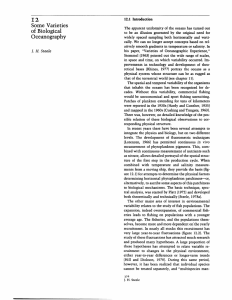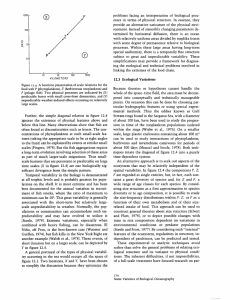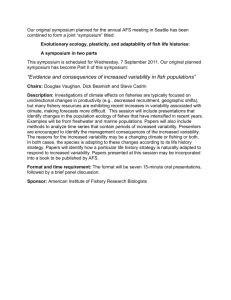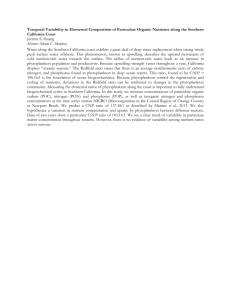I2 Some Varieties of Biological 12.1 Introduction
advertisement
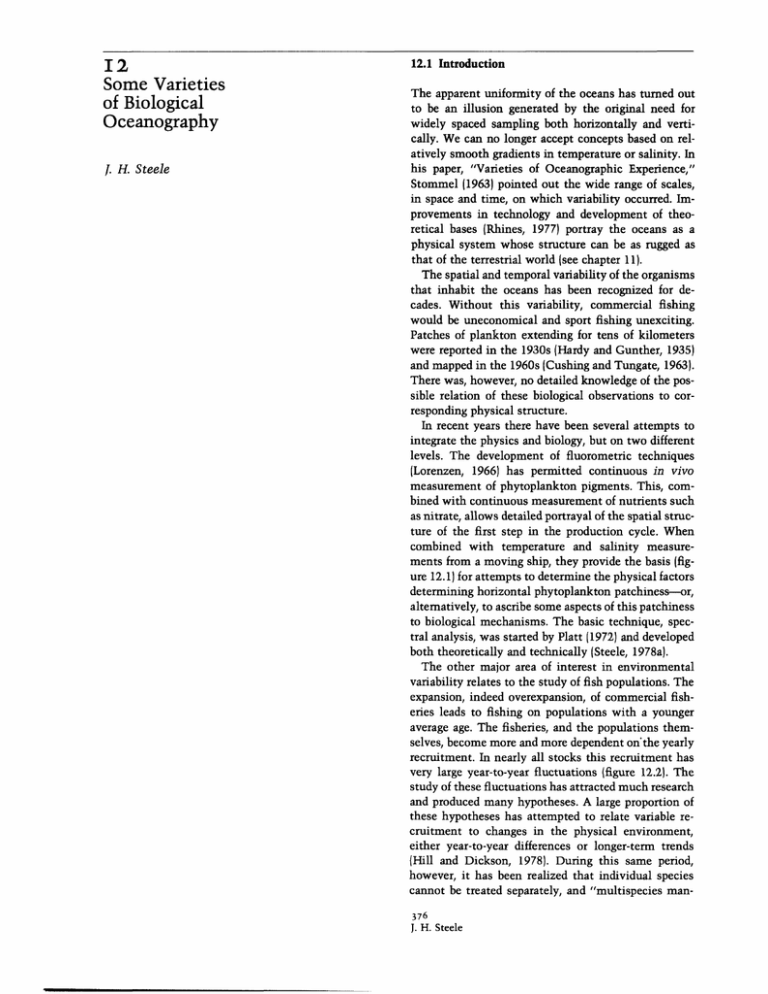
I2 Some Varieties of Biological Oceanography . H. Steele 12.1 Introduction The apparent uniformity of the oceans has turned out to be an illusion generated by the original need for widely spaced sampling both horizontally and vertically. We can no longer accept concepts based on relatively smooth gradients in temperature or salinity. In his paper, "Varieties of Oceanographic Experience," Stommel (1963) pointed out the wide range of scales, in space and time, on which variability occurred. Improvements in technology and development of theoretical bases (Rhines, 1977) portray the oceans as a physical system whose structure can be as rugged as that of the terrestrial world (see chapter 11). The spatial and temporal variability of the organisms that inhabit the oceans has been recognized for decades. Without this variability, commercial fishing would be uneconomical and sport fishing unexciting. Patches of plankton extending for tens of kilometers were reported in the 1930s (Hardy and Gunther, 1935) and mapped in the 1960s (Cushing and Tungate, 1963). There was, however, no detailed knowledge of the possible relation of these biological observations to corresponding physical structure. In recent years there have been several attempts to integrate the physics and biology, but on two different levels. The development of fluorometric techniques (Lorenzen, 1966) has permitted continuous in vivo measurement of phytoplankton pigments. This, combined with continuous measurement of nutrients such as nitrate, allows detailed portrayal of the spatial structure of the first step in the production cycle. When combined with temperature and salinity measurements from a moving ship, they provide the basis (figure 12.1) for attempts to determine the physical factors determining horizontal phytoplankton patchiness-or, alternatively, to ascribe some aspects of this patchiness to biological mechanisms. The basic technique, spectral analysis, was started by Platt (1972) and developed both theoretically and technically (Steele, 1978a). The other major area of interest in environmental variability relates to the study of fish populations. The expansion, indeed overexpansion, of commercial fisheries leads to fishing on populations with a younger average age. The fisheries, and the populations themselves, become more and more dependent on'the yearly recruitment. In nearly all stocks this recruitment has very large year-to-year fluctuations (figure 12.2). The study of these fluctuations has attracted much research and produced many hypotheses. A large proportion of these hypotheses has attempted to relate variable recruitment to changes in the physical environment, either year-to-year differences or longer-term trends (Hill and Dickson, 1978). During this same period, however, it has been realized that individual species cannot be treated separately, and "multispecies man376 J. H. Steele 8 Temperature 7 tl 5 Chlorophyll 2 AI J V 35.3 Salinity I 35.2 35.1 _~~~~~ . r) .. 6 4 N Nitrate 2 :- i 0 5900'N 58030' Figure I2z. Measurements made at 3 m in the northern North Sea during the hours 0000-0500 on 16 May 1976. There are no obvious relations between variations in chlorophyll and nitrate, or between these and the physical parameters temperature and salinity. *60 15 %K10z 63. .69 .62 c;5 *67 · 70 · 66 · 73 *71 .58 .53 54 .61 65 .57 *64 · 55 .68 76 72 59. 75 5674 , , agement" is now in vogue. This recognizes the interrelation between species, in their food requirements and, potentially, in their recruitment. Thus, again, there is a need to separate the physical and biological factors acting to produce the observed distribution and abundance of fish populations. For these two extremes of the food web, phytoplankton and fisheries, there is an extensive literature, which I shall review very briefly. For both, it is apparent that the biological factors limiting our understanding lie in the intermediate components of the food web-the zooplankton, which graze on the plants and which, in turn, are the source of food for the fish populations. But these interactions must be placed in the context of the variability of the physical environment at a wide range of space and time scales. These problems are applicable to all regions of the sea, but, scientifically and economically, are most acute in areas of the continental shelf. Certain parts of the open ocean, such as the centers of gyres (Eppley, Renger, Venrick, and Mullin, 1973), may be considered relatively uniform horizontally, but the shelf is dominated by changes in all significant physical, chemical, and biological parameters-depth composition of the bottom, temperature, salinity, nutrients, and the quantity and quality of living organisms-at all the possible horizontal scales. Moreover, there is an equally great variability in the vertical structure of the water column, and this variability is conditioned by, and related to, horizontal changes. An example of vertical changes is shown (figure 12.3) in the close correspondence between temperature and fluorescence during passage of an internal wave packet produced by variable bottom topography in Massachusetts Bay. For these reasons, there is an emphasis in this chapter on variability in coastal areas. 5 i, Ii, 10 , , , , 15 , , 12.2 Space and Time Scales of Variation 8/OMASS(10-5ons} SPAWNING STOCK Figure z2.2 Year class strength of North Sea herring as a function of the biomass of the spawning stock. Only in the final years of stock collapse, 1974-1976, do the values of recruitment fall outside the range of previous variability. (Ulltang, in press.) 12.2.1 Physical Variation As a point of departure, it is necessary to start with certain observed regularities that relate to patterns of horizontal variability. Experiments on dye dispersion by Okubo (1971) and others show a consistent relation between the variance of concentration across a patch and the time from release of the dye. This relation demonstrates the expected dependence of horizontal diffusivity on spatial scale. Using the standard deviation o derived from this variance, the relation with time t is, approximately, Or = t 1.17 (12.1) where the units are kilometers and days (Steele, 1978b). This almost linear relation suggests that populations spreading from some initially small area should have a patch "size" in kilometers numerically similar to 377 Some Varieties of Biological Oceanography TEMPERATURE I! I f' tl l 10 20 30 40 10 20 30 40 50 ~ ~~ ~ ~ ~ ~ ~ ~ ~~~: ---------- 6-0 iK it'% ql It 20 30 40 50 WL -- cr .. . . . . FLUORESCENCE . . _ ---------- 'ZWEIM, ----------- 1100 . m . . m · . L . .... .. * 1130 TIME . , 3 .. . ---------- 175 ------. "_ '? 10 20 30 40 50 . , I , t , I , I , I~ I N 1200 30 AUGUST p977 Figure I2.3 The passage of an internal wave packet past a drifting ship in Massachusetts Bay produces rapid changes in vertical structure, shown by the temperature profiles, with a close correspondence of the changes in fluorescence that gives a measure of the concentration of phytoplankton. (Haury et their lifetime in days. Yet such a relation cannot be general. Not only will land boundaries limit the extension, but internal vertical features, such as fronts, will alter radically the way in which variance changes with time. The general effect of such boundaries is partly predictable when they have some measure of permanence. But there are also highly unpredictable events, associated with weather, that can alter significantly the temporal variability. These events tend to have their greatest impact on the shelf, particularly near coasts (Csanady, 1976). Thus persistent fronts (Pingree, 1978) and wind-driven motions produce features whose combined time and length scales are very far from the relation derived in equation (12.1). Further, there are questions about the adequacy, in a biological context, of representing horizontal changes by a process of eddy diffusivity. This concept ignores the related vertical features. An alternative (Taylor, 1954; Bowden, 1965; Kullenberg, 1972) derives horizontal dispersion explicitly in terms of vertical processes. A combination of vertical shear and vertical mixing can explain much, but not all, of the horizontal dispersion. Potentially, this can be used to describe temporal changes in rates of dispersion due to variations in wind stress. This picture has considerable advantages in the study of particles, living or inorganic, that move vertically through the water. At this stage in the discussion, the concept of horizontal diffusion has a provisional and heuristic value. kilometers at which growth rate of a phytoplankton population P can overcome physical dispersion processes to cause biologically induced patchiness. At the other extreme, pelagic fish F such as herring in the North Sea, have an average life span of a few years and an ambit, produced by their annual migrations, on the order of 1000 km. Herbivorous zooplankton Z are the main link between phytoplankton and pelagic fish in the food chain. Copepods, which are the dominant herbivores, have a life span of 20-50 days (Marshall and Orr, 1955), and there is some evidence for patches of copepods on scales of tens of kilometers (Cushing and 12.2.2 Biological Variation When we turn to the plant and animal populations, a similar and very simplified portrayal of space and time scales has been used to indicate the main features of variability (P,Z, F) at different trophic levels (figure 12.4) (Steele, 1978b). The life span of individual phytoplankton cells is a few days. Theoretical calculations (Steele, 1975) suggest that there is a critical scale of a few al., 1978.) Tungate, 1963). The simple linear P-Z-F derivation in figure 12.4 is, once again, a heuristic device to emphasize the scale relations. These connections imply that any ecological interrelations in the food chain necessarily require interactions between different space and time scales. Thus the inherent difficulties, technical as well as conceptual, in modeling or sampling the complete range of physical events in the ocean, apply equally to the modeling and sampling of the related biological processes. From equation (12.1) and figure 12.4, it appears that there is a rough correspondence between the scales in space and time of physical and biological dispersion. This could imply that the biological system has evolved to take advantage of the regularities associated with the general temporal and spatial character of physical dispersion in the sea. This is too simple since it ignores the actual relations involved. Theories of phytoplankton patchiness have been based on horizontal diffusivity, but pelagic fish migration is usually associated with, and possibly related to, particular features of current systems (Harden Jones, 1968). Also, zooplankton aggregations may depend on the combination of their own vertical migration and the vertical shear in the water column (Hardy and Gunther, 1935; Evans, 1978). 378 J. H. Steele II- rnl h 1UUU (X_ 100 C2l) 10 N Ku H 1.0 I 1.0 I 10 I 100 I 1000 KILOMETERS 12.3 Ecological Variations Figure I2.4 A heuristic presentation of scale relations for the food web P (phytoplankton), Z (herbivorous zooplankton) and F (pelagic fish). Two physical processes are indicated by (X) predictable fronts with small cross-front dimensions, and (Y) unpredictable weather-induced effects occurring on relatively large scales. Further, the simple diagonal relation in figure 12.4 ignores the existence of physical features above and below this line. Many observations show that fish are often found at discontinuities such as fronts. The concentrations of phytoplankton at such small-scale features (taking the appropriate scale to be at right angles to the front) can be explained by events at similar small scales (Pingree, 1978). But the fish aggregations require a long-term evolution involving selection of these areas as part of much larger-scale migrations. Thus smallscale features that are persistent or predictable on large time scales (X in figure 12.4) are one biologically sig- nificant divergence from the simple pattern. Temporal variability in the biology is demonstrated at all trophic levels and is probably greatest for populations on the shelf. It is most extreme and has been best documented for the annual variation in recruitment of fish stocks, where the ratio of maximum to minimum can be 103. This great variability is generally associated with the short-term but relatively largescale unpredictability in weather. Normally, the populations or communities can accommodate such unpredictability and may have evolved to utilize it (Steele, 1979). Extreme variations, especially when combined with heavy fishing, can be disastrous. El Nifio, off Peru, is the best-known problems facing an interpretation of biological processes in terms of physical structure. In essence, they provide an alternative caricature of the physical environment. Instead of smoothly changing parameters determined by horizontal diffusion, there is an ocean with relatively uniform areas divided by steplike fronts with some degree of permanence relative to biological processes. Within these large areas having long-term spatial uniformity, there is a temporally fine structure subject to great and unpredictable variability. These simplifications may provide a framework for diagnosing the ecological and technical problems involved in linking the extremes of the food chain. case (Wooster and Guillen, 1974), but fish kills in the New York Bight are another example (Walsh et al., 1978). These events, of short duration but on a larger scale, can be depicted by Y in figure 12.4. A general portrayal of the types of physical variability occurring in the sea would occupy all the space of figure 12.1. Two locations, X and Y, have been chosen to simplify the discussion because they epitomize the Because theories or hypotheses cannot handle the whole of the space-time field, the area must be decomposed into conceptually and technically manageable pieces. On occasion this can be done by choosing particular hydrographic features or using special experimental methods. Thus the eddies known as Gulf Stream rings found in the Sargasso Sea, with a diameter of about 100 km, have been used to study the progression in time of the zooplankton populations isolated within the rings (Wiebe et al., 1976). On a smaller scale, large plastic enclosures containing about 100 m3 can be used to study interactions of phytoplankton, herbivores and invertebrate carnivores for periods of about 100 days (Menzel and Steele, 1978). Both techniques rotate the diagonal of figure 12.4 into a purely time-dependent system. An alternative approach is to seek out aspects of the ecosystem that may be relatively independent of the spatial variability. In figure 12.4 the components P, Z, F are regarded as single entities, but, in fact, each contains a great diversity of species and, for Z and F, a wide range of age classes for each species. By considering size structure as a first approximation to species diversity or to age composition, it is possible to study the size-frequency distributions within P, Z, or F as a function of their own metabolism and of their sizerelated intake of food. This approach can be used to construct general theories about size structure (Silvert and Platt, 1978), or to depict possible changes with time in size composition dependent on variations in environmental conditions or predator populations (Steele and Frost, 1977). By considering such "internal" features of the ecosystem, regularities in structure, independent of patchiness, can be predicted and tested. These experimental or analytic techniques avoid rather than solve the general problems of relating ecological structure and its variance to physical conditions. The inherent difficulties, if not impossibilities, of a full-scale treatment have focused research on par- 379 Some Varieties of Biological Oceanography


